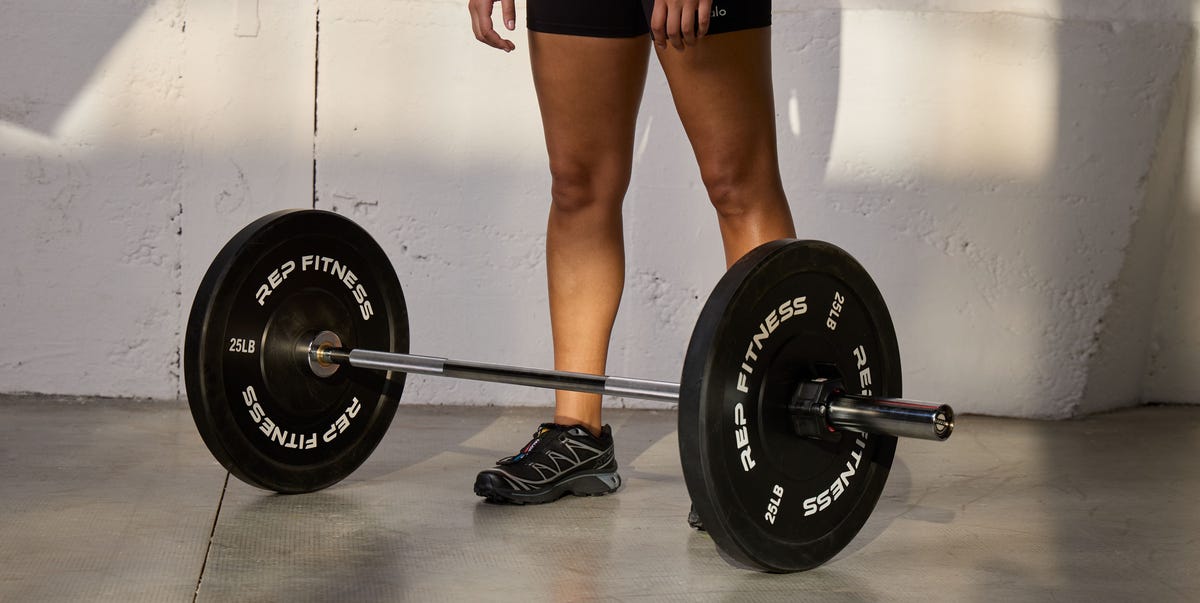If you’ve ever been posted up at the squat rack, wondering how heavy you can lift, there’s a simple way to figure out just how strong you really are.
Enter: the one-rep max (1RM), or “the maximum amount of weight that you can lift for just one repetition,” says physical therapist and strength and conditioning specialist Rachel Tavel, DPT, CSCS. “It’s used as a benchmark during strength training, so you have a starting point.” From there, you can set goals and track your progress along the way.
Meet the experts: Rachel Tavel, DPT, CSCS, is a physical therapist and strength and conditioning specialist based in New York City. Ashley Joi, CPT, is a trainer based in Los Angeles.
Let’s say your one-rep max for deadlifts is 100 pounds, and your goal is to deadlift 150 pounds. You can start training at a percentage of your initial one-rep max (more on exactly how to do this later). Every week or two, reassess to see if your one-rep max is increasing. “The idea is you keep practicing at a high percentage of the initial amount and see if you can make that amount grow,” Tavel says. “You’re developing adaptations in your muscles to accommodate the higher loads.”
Ahead, find out who should use the one-rep max, how to find yours, why knowing it is important, and how to improve it.
Why Knowing Your One-Rep Max Is Important
It can help gauge how strong you are with a specific movement, and help you safely and effectively increase that number, as well as track your progress. Anyone can use their one-rep max to achieve their fitness goals, but it’s most helpful for those who are experienced with weight training and want to lift heavy and/or find their maximum weight for an exercise, as well as powerlifters and Olympic weightlifters who compete in formats that test one-rep max for specific lifts.
Typically, you traditionally use your one-rep max for compound multi-joint barbell lifts, like deadlifts, bench presses, and squats, as opposed to a more simple movement like biceps curls, Tavel and trainer Ashley Joi, CPT, say.
You can use your 1RM for simpler movements, but it’s not really necessary because you’re using smaller muscles and an isolated joint, Tavel says. That means that the 1RM test can be more risky because “a single muscle is more prone to injury when it doesn’t have a back-up,” she adds. Moves that engage multiple muscles and joints are generally more reflective of real-life movement patterns and better reflections of total-body strength and athletic performance, depending on the sport.
How To Find Your One-Rep Max
Go by feel.
- First, warm up. For example, if you’re squatting, do one set of 10 bodyweight squats.
- Add weight that feels decently heavy, but not impossible to lift, and try 10 reps. You should feel pretty exhausted at the end of the set, Tavel says. (This process might require a bit of trial and error.)
- Then, take about a five-minute break to let your muscles recover “because it might not be an accurate one-rep max if you totally fatigue yourself before doing it,” says Tavel. You can also make sure your heart rate returns between zone 1 or 2 (about 50 to 70 percent of your maximum heart rate, or 220 – your age), on your fitness tracker, Joi adds.
- Then, ramp up the weight by five or 10 pounds and see if you can crank out two or three reps with good form. If you can, you’re close to your 1RM. Rest for five minutes again.
- Increase your weight slowly until you can only crank out one rep.
Use a calculator.
There are a few equations you can use to find your one-rep max, but it’s easier to estimate your number through a calculator, like this one from the National Academy of Sports Medicine (NASM). You select your exercise (general lifts, deadlifts, squats, or bench presses), then input the current weight you’re lifting and your current rep amount, and it’ll estimate how much weight you can lift for 75 to 100 percent of your 1RM. (The lower amount of reps you select, the more accurate the calculator is.)
Tavel says that, between these two methods, going by feel is probably more accurate. Still, you can always use a calculator to figure out your one-rep max and use it as a tool, but it’s not the end-all-be-all. The 1RM should be a guideline, but “our bodies are not machines,” Tavel says. “It’s not a perfect science.” Your one-rep max may vary day to day, too, based on sleep, stress, muscle fatigue, and more.
How To Use Your One-Rep Max
Here’s how to use this number, whether you’re training for strength, endurance, or hypertrophy:
- Strength is how much you can lift, says Tavel. If you want to train strength, lift about 85 percent of your max for two to six reps and two to six sets, Tavel says. Then, rest for two to five minutes in between sets.
- Endurance is how long your muscles can sustain exercise, says Joi. For this goal, train 50 to 65 percent of your one-rep max for 12 to 25 reps and two to three sets, resting for 30 seconds between sets, Tavel says.
- Hypertrophy is the size of your muscles growing, says Tavel. If hypertrophy is your goal, lift 70 to 80 percent of your 1RM for eight to 12 reps and three to six reps per set, Tavel says. Rest for 30 to 90 seconds in between sets.
How To Improve Your One-Rep Max
You’ll need to work out consistently to lift the percentage of your 1RM that suits your fitness goals—but here are some other tips for increasing that number:
- Work out with a buddy (or a trainer). They’ll be able to hold you accountable and help you keep track of your weights and reps, says Joi.
- Use a journal to track your progress. Write down your weights and how you felt on a specific day, and if it keeps feeling easier, it’s time to lift heavier weights. If you don’t have a physical paper journal, you can use your phone’s notes app, text yourself, or post on social media to hold yourself accountable, Joi adds.
- Let your body rest by avoiding targeting the same muscle groups two days in a row. “Your body needs time to rest, recover and adapt to the loads,” says Tavel. “The repair process makes it stronger.”
Want more workout advice? Join Women’s Health+ today for member-exclusive workout and meal plans.
When To Reevaluate Your One-Rep Max
Tavel recommends reassessing your 1RM every two weeks. Here are some signs that it’s time:
- Your weight doesn’t feel as challenging. Maybe you’ve done three sets of seven reps at 80 percent of your one-rep max during three training days in a week, and it starts to not feel that hard, like you could crank out one or two more reps.
- It takes you less time to recover. Say on your first day of working out with a new plan, it takes you three full days to recover and not feel sore anymore. But maybe a few weeks into said plan, you recover faster after one or two days after a hard workout, Joi says.
- You’re putting in less effort. After a few training sessions—or weeks—you feel like it takes less effort to lift the same amount of weight, Joi says.
If any of these signs sounds like you, reevaluate your one-rep max by increasing it two and a half or five pounds in weight and see how it feels, Tavel says.
The one-rep max is a fun tool to use and gauge your strength, but you should always listen to your body instead of trying to hit a certain percentage of it because you won’t feel strong and amazing every single workout, says Tavel. Even if you’re feeling crappy one day—like you can’t lift as much—because you’re on your period, you’re stressed about work, or you slept horribly, it’s totally fine. As long as you’re improving in the long run, you’ll become stronger. “Always remember to listen to yourself despite what’s on paper,” or your notes app, says Joi.
Addison Aloian is the associate health & fitness editor at Women’s Health, where she writes and edits across the health, weight loss, and fitness verticals. She’s also a certified personal trainer through the National Academy of Sports Medicine (NASM). In her free time, you can find her lifting weights at the gym, running on the West Side Highway in New York City—she recently completed her first half-marathon—and watching (and critiquing!) the latest movies that have garnered Oscars buzz. In addition to Women’s Health, her work has also appeared in Allure, StyleCaster, L’Officiel USA, V Magazine, VMAN, and more.
Read the full article here




